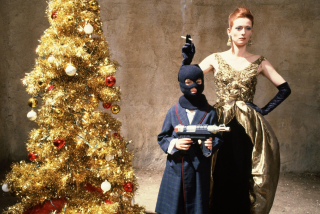Garbo glows and Jolson crows
- Share via
How might Greta Garbo have appeared had she mounted a comeback?
Fans can get a glimpse tonight at the Egyptian Theatre when footage from the actress’ 1949 screen test is shown as part of Treasures From Cinema’s Attic: Rarities From the SabuCat Archives.
Cineastes know that the closest Garbo came to a comeback was a Max Ophuls film, “La Duchesse de Langeais,” but its financing fell apart. Garbo went so far as to submit to screen tests in May 1949, eight years after her last film, and at 43 she is relaxed and so radiantly beautiful that her test, surely this collection’s high point, is inevitably a poignant what-might-have-been.
The 90-minute collection also includes the only known moving images of writer Carson McCullers -- a brief 1952 interview in a restaurant, apparently in connection with the opening of the film of her play “Member of the Wedding.” Her interviewer is a tad unctuous, but McCullers comes across as a gracious Southerner who quietly explains she doesn’t think of sending messages but is trying to express everyone’s need to belong.
Also among the rarities:
So successful was “The Jolson Story” (1946) that it spawned a sequel, “Jolson Sings Again” (1949), and SabuCat obtained footage of a still-exuberant Al Jolson singing and dancing to a playback of “Me and My Gal” so that Larry Parks, who played Jolson in his film bios, could emulate his moves. Cut from “Second Chorus” (1940) was Fred Astaire’s “Me and the Ghost Upstairs” number, in which Astaire first sings the rather inane song then dances to it deftly partnered with legendary choreographer Hermes Pan, in high heels and hidden in a veiled ghost drag costume.
Some bits and pieces are silent -- e.g., a 14-second color test for the Marx Brothers’ “Animal Crackers” (1930); a 1956 costume test with Lauren Bacall and Humphrey Bogart for “Melville Goodman,” never made because of Bogart’s illness; some 1938 home movie shots, in rich color, of the neon signs of Times Square followed by glimpses of Mae West performing in her revue at the Loews State; footage of the devastation created by the 1933 Long Beach earthquake; and mid-’40s color home movie shots of stars such as Ingrid Bergman (strolling with Alfred Hitchcock and his wife, Alma Reville), Betty Grable, Jane Russell, Rita Hayworth.
Grassroots projects
Grassroots Cinema will be showcasing five features and five shorts on a rotating basis at the Vine Theater. Among them is Brian Flemming’s provocative -- to put it mildly -- “The God That Wasn’t There,” a documentary challenging the literal interpretation of the Bible made by a onetime born-again Christian. Flemming begins by telling the story of Christ through clips from a century-old silent movie and a 1952 Family Films production called “The Living Bible.” His prologue features Christians, fresh from a Billy Graham revival last November, speaking happily of Jesus Christ as their savior, but then Flemming starts surveying the dark side of Christianity, culminating in a tabulation of the extreme violence of Mel Gibson’s “The Passion of the Christ,” far and away the most popular depiction of Jesus.
Much of the film is composed of interviews -- including one with his former religious school’s superintendent, who eventually walks out on him -- with a cross-section of scholars and academics who stress the importance of viewing the Bible mythologically rather than literally.
Loren-Paul Caplin’s ironically titled “The Lucky Ones” is a real discovery, an ambitious work of much texture, density and scope in which a young reporter (Ivan Martin) is caught up in a sleazy dolce vita as a reporter for FAME-TV, a cheesy cable channel, for which he endlessly pursues celebrities, mainly C-level. Yet Martin’s Lorenzo has higher aspirations, and the film propels him to a stunningly orchestrated moment of truth.
Pre-Code sinners
“Bondage,” part of the UCLA Film Archives’ Sin Uncensored: Hollywood Before the Code, is a remarkably unsparing account of the plight of the unwed mother in a hypocritical, puritanical society. Dorothy Jordan is highly affecting in this 1993 Alfred Santell film based on a novel by Grace Sothcote Leake. Followed by “Sinners in the Sun” (1932), in which Carole Lombard and Chester Morris learn that money isn’t everything.
*
Screenings
Treasures From Cinema’s Attic: Rarities From the SabuCat Archives
Where: Egyptian Theatre, 6712 Hollywood Blvd., Hollywood
When: 8 tonight
Info: (323) 466-FILM or egyptiantheatre.com
Grassroots Cinema
What: Five features (including “The God That Wasn’t There” and “The Lucky Ones”) and shorts, on a rotating basis.
Where: Vine Theater, 6321 Hollywood Blvd., Hollywood
When: Friday through June 9
Info: (323) 337-2070 or www.grassrootscinema.com
UCLA Film Archive
* “Bondage,” followed by “Sinners in the Sun,” 7:30 p.m. Saturday
Where: James Bridges Theater, Melnitz Hall, UCLA, Westwood
Info: (310) 206-FILM
More to Read
Only good movies
Get the Indie Focus newsletter, Mark Olsen's weekly guide to the world of cinema.
You may occasionally receive promotional content from the Los Angeles Times.










